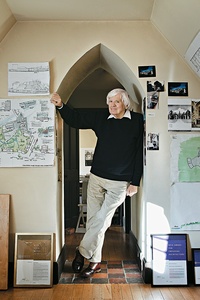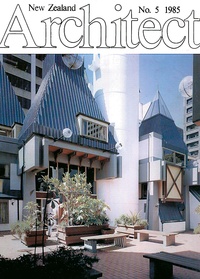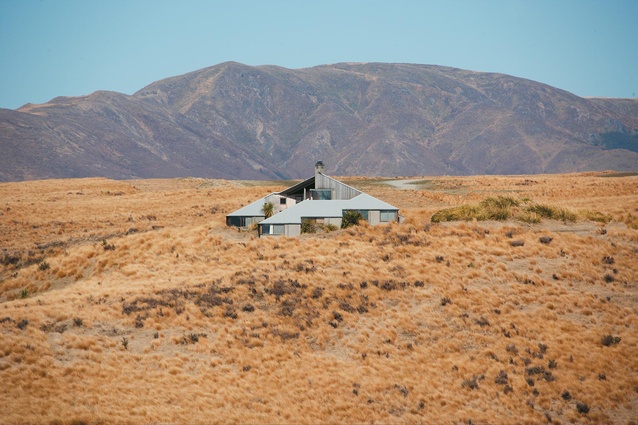The new romantics
Peter Beaven takes us back in time to 1972 when new ideas about architecture were taking shape and exhibited at The Dowse Gallery in Lower Hutt.

I designed two houses at about the same time, the Ross House and the Blenheim House, in the first four years after my return from London in 1984. The commissions came to me in similar circumstances. In both cases, I was not the first architect the owner thought of. Each had been waiting for the services of more obviously romantic architects: Ian Athfield in one case and John Scott in the other. My own architectural romanticism, stemming from Mountfort’s Gothic Revival buildings, was more difficult to reproduce and understand than was the evident romanticism and well-published work of Athfield and Scott.
This interest in new shapes and styles first took visible form at The Dowse Art Gallery in Lower Hutt in 1972. An architectural exhibition which the Dowse labelled The New Romantics, included the work of Ian Athfield, Roger Walker, Claude Megson, John Scott and myself. There were, by then, already salient differences among us. For a small country, the architects featured in the exhibition were a pretty excellent assembly, developing as a group several clear, broad paths, which could have taken New Zealand architecture beyond modernism into rich new fields of our own.
Instead, as we know, deregulation and the international media took over. For five architects to break away so decisively, at that time, from modernism would have been unusual anywhere. But, it was so unusual for a little country like New Zealand.

I would argue that we had many things in our favour. First, a real democratic freedom given by a very equal society, full employment (which always lessens worry), an equable climate (which is easy to build in) and, of course, fine local building materials, mostly our own and fully understood by all of us.
In addition and most importantly, the rules were still made in a democratic manner with open discussion. Most excellently, the first-class scientists at the Department of Scientific and Industrial Research at Petone monitored the practicalities of building. Nearly all of this was swept away by deregulation in 1984 with all the now very-apparent agony of leaky homes, unsuitable architecture, ever proliferating rules and finally, building materials from every corner of the world.
Inevitably, the ‘new romantic’ movement never really flowered. Neither John Scott nor Claude Megson lived long enough to extend their great formal skills. Ian Athfield and Roger Walker each developed large practices. In the running of their practices, their early enthusiasm and originality necessarily drained away to some extent. Each now inhabits a different world from the world that the Dowse exhibition seemed to be ushering in.
It is far harder today for a young architect to make such an individual impression. The fashion for following the favoured styles of the day has become uniform throughout the world, driven of course by the insatiable flood of images everywhere, which can only overwhelm local romanticism.
Ian Athfield, born and raised in Christchurch, worked for Warren and Mahoney for a short time, learned how it was done and realised that Christchurch was too limiting for him. He went off to Wellington. There, with a brilliant insouciance of personality and creativity – which showed up so strongly against the drab modernist Wellington of the time – he made for himself one of the outstanding careers in New Zealand architecture.
One day at a conference, Michael Fowler, a Wellington architect and later the mayor, asked me what he should do, having just inherited one of the best old architectural practices in Wellington, to stiffen the design talent of the firm. “Go to the school in Auckland,” I advised him, “and take on the best emerging creative designer.” Months later he leant out of his office window high above as I was descending Plimmer Steps and shouted, “Come up!” And, there was Roger Walker.
From that office during those years came the wonderful Wellington Club, one of the greatest romantic structures ever built in New Zealand. Because Roger Walker had so recently left the School of Architecture, his visual eye was still full of student excitement, fired by the Sea Ranch Condominium and the new architecture recently finished in California. The astonishing freedom of sculptural shapes in these buildings overlooking the Pacific still retained the vigour of old functional vernacular buildings. The quality of remembrance and freshness swept the world.
Within the rich romantic expressiveness of this architecture – which was all wonderful – Walker and Fowler managed to include the staid polished elegance of a gentlemen’s club. It was an astonishing achievement and loved by the members. A very pure example of just what a truly original country this is. It was demolished very quickly and tragically to make way for a supposedly more economic office block, designed by Warren and Mahoney, which occupied much of the site. This meant of course that the recent Walker and Fowler club had to be demolished.
Personally, I believe that the new building could have been designed to allow the Walker and Fowler club to be retained. That is a large story still to be written. This was a tragedy at all levels. With the new monied owner of Wellington, the intense romanticism of Walker’s club might have added some modicum of more humane understanding to dictates from the Capital scene.
Claude Megson, another of the ‘new romantics’, was an Auckland architect who had a remarkable talent for astonishing manipulation of small spaces into great spatial experiences. Auckland, ever urgently wanting new experiences, gave him plenty of opportunities.
John Scott is my favourite recent New Zealand architect. Part Scottish, part Maori, he expressed his ancestry with consummate creative ease. He studied the work of the Christchurch school – white-painted concrete blocks with stained timbers (our rimu, matai, etc., of course) rising into complex, almost gothic, roof spaces. Scott married the idioms of the Christchurch School to the remarkable sense of land, of place, which Maori people possess so fully. Ngamatea remains, in my opinion, the finest modern house in New Zealand.
And finally, the reason for my inclusion among the ‘new romantics’ was simply that I had grown to love the adaptation of gothic revival to local conditions, which Benjamin Mountfort has achieved with such romantic brilliance in 19th-century Christchurch. A number of worldly critics, after seeing his architecture, have claimed it equal to the best gothic revival work anywhere in the old British Empire. To this love and admiration of Mountfort’s work was added my general love of history and a total aversion to modernism beginning at my first day at the School of Architecture in Auckland.
Our very different paths to the same romantic destination shows what a richly diverse culture we had developed in New Zealand, before we were told by America we could no longer have our country the way we had made it. Here we were, a complete, brand-new egalitarian England, a brilliant realisation of noble ideals which had made New Zealand, so Karl Popper said when he got back to Vienna in 1946: “the best-governed country in the world”.
That observation returns me, once again, to the tragic change in the character of New Zealand after 1984 when consumerism and a system of legal blame replaced trust and took over from our old natural fairness. The strands of originality in the work of the five architects identified by the Dowse began to wither away after 1984.
You can see this in a vivid, visual manner if you place any copy of Houses magazine beside the book NZ Architects’ Houses, 1970. In the 1970 publication, page follows page of rich spatial delight: architecture of the greatest originality, all stemming from the use of our limited building materials and our trust in each other – builder and architect – which was typical of old New Zealand.
The 1970s’ book shows that a great number of New Zealand architects at that time were all doing really beautiful, original work, very much our country. Houses magazine, of course, does its best but it can only show that the 1970s’ New Zealand originality, in most cases, has faded into varying streams of international modernism.










